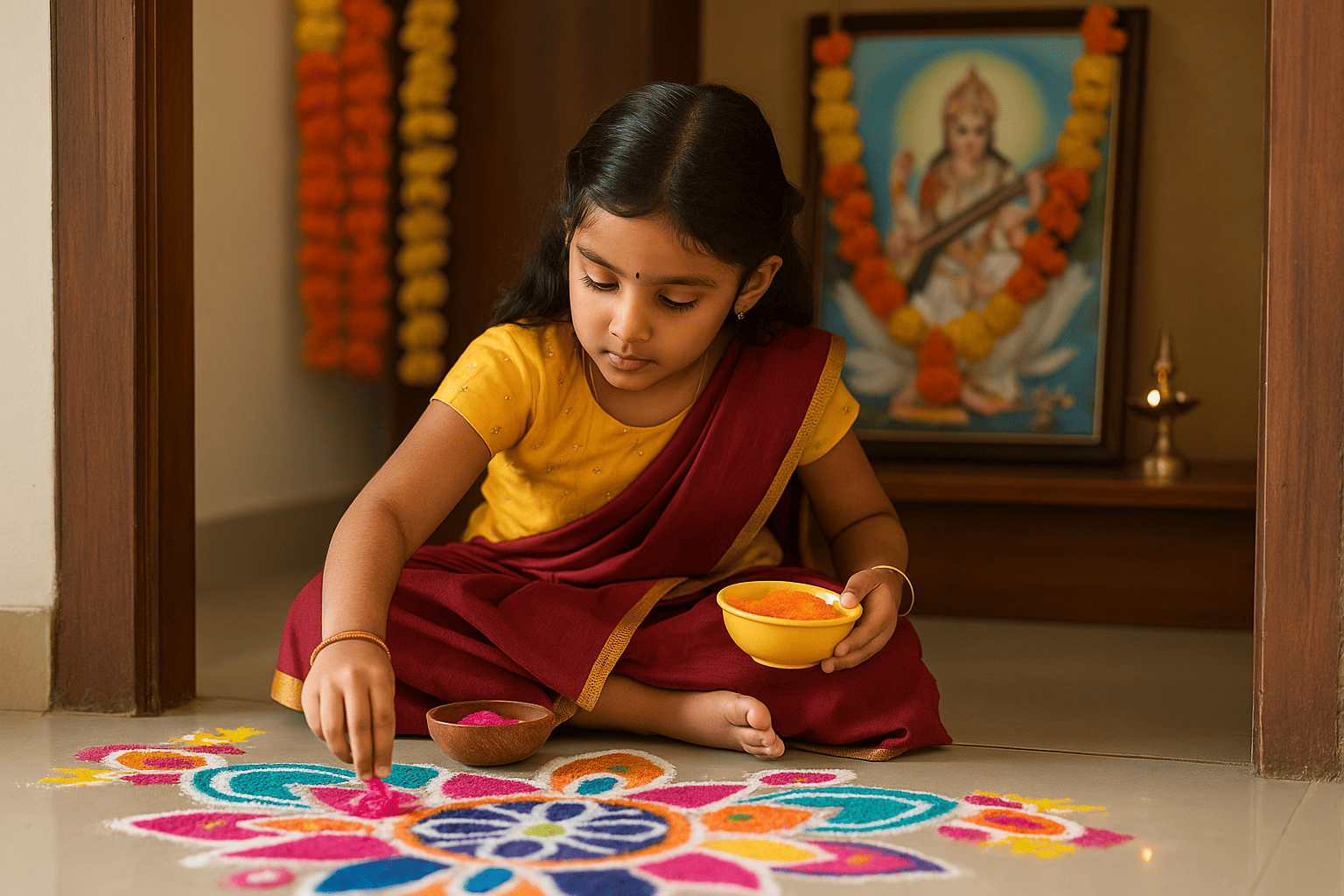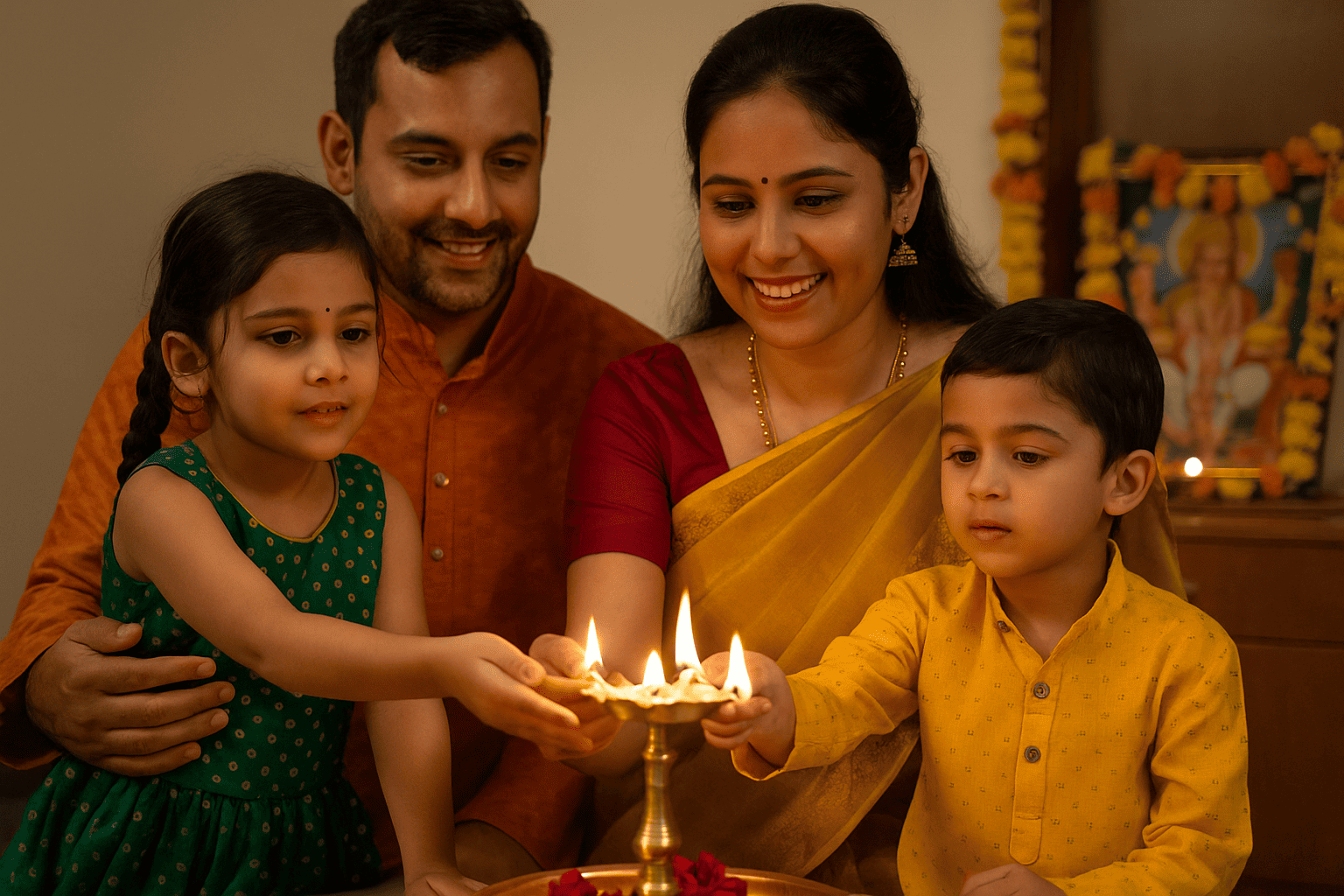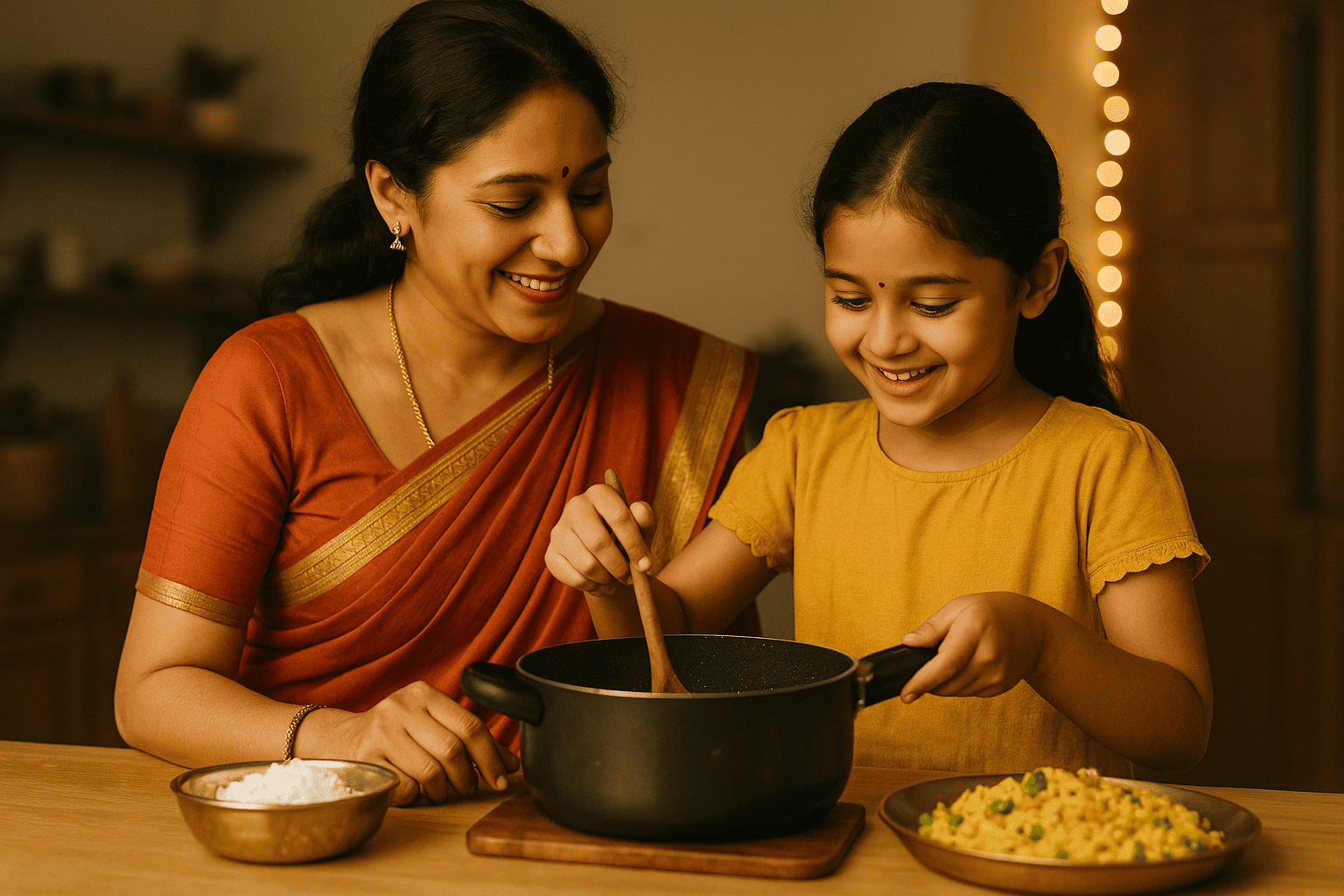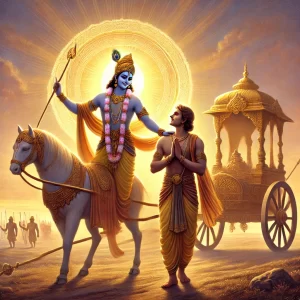
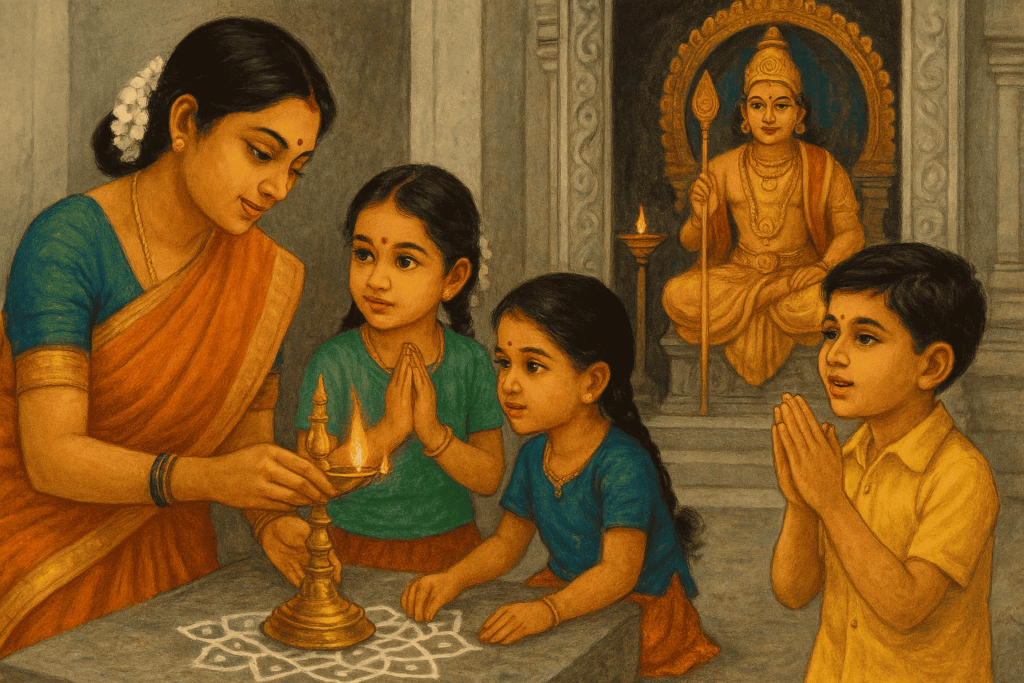
In the quiet hours before sunrise, when most of the world is still wrapped in sleep, a gentle rhythm begins in many Tamil Hindu homes. A mother, clad in a soft cotton saree, sweeps the front yard and sprinkles water on the floor. Then, with practiced hands, she begins to draw a kolam, a geometric design made with rice flour, at the doorstep. Her child, barely awake, peeks through the window, watching the lines and curves take form. This is no ordinary start to the day. This is tradition—alive, present, and lovingly passed on.
Tamil Hinduism is not just a religion. It is a lived experience, woven seamlessly into everyday life. It breathes in the rituals of the home, sings in the temples of ancient towns, and celebrates through grand festivals that paint entire streets with color, sound, and spirit. For young minds growing up in Tamil culture, these traditions are more than customs; they are identity, grounding, and a bridge to something larger than themselves.
For many Tamil children, stories of gods and goddesses are among their very first bedtime tales. But unlike fairy tales tucked away in books, these stories live in their surroundings.
They hear about Murugan, the youthful and valiant son of Shiva and Parvati, who rides a majestic peacock and wields a spear of light — the Vel. To them, he’s not just a deity but a heroic protector, a brother figure who watches over them. His story is not just told but lived — during festivals, temple visits, and even in everyday prayers.
Murugan’s six sacred abodes — the Aaru Padai Veedu — each carry their own legend, and visiting them is like flipping through the pages of a living epic. From the coastal breeze of Thiruchendur to the lush hills of Palani, each place tells of bravery, wisdom, and divine love.
Children who visit these temples aren’t just tourists. They’re seekers. They listen to elders speak of how Murugan vanquished demons and protected dharma. They walk barefoot, offer flowers, and chant “Om Saravanabhava,” slowly understanding that these tales aren’t just myths — they are reflections of inner strength, courage, and goodness.
Tamil temples are a marvel — not only in their towering gopurams and intricate carvings but in the way they hold space for community and connection. For a child, entering a temple is like stepping into a sacred playground of the senses. The scent of camphor, the sound of temple drums, the warm oil lamps dancing in the breeze — it’s a place where stories take shape and gods feel close.
Temples are also classrooms without walls. A child might learn math while counting prasadam packets, or language while reciting ancient Tamil hymns. They’ll learn patience while waiting in line, and respect as they bow before elders and deities alike.
Even in the smallest village temples, the experience is layered with meaning. One doesn’t just visit a temple — one experiences it. It’s a journey of the heart.
If temples are the soul of Tamil Hindu tradition, festivals are its heartbeat. The Tamil calendar is sprinkled with celebrations — each one more vibrant than the last — and children often mark time by them.
There’s Pongal, the harvest festival that celebrates the Earth’s bounty. Children wake up early to help decorate courtyards, prepare sweet rice, and thank the Sun for its warmth. It’s a lesson in gratitude wrapped in joy — and sugarcane.
During Karthigai Deepam, homes glow with rows of oil lamps, each flame a whisper of ancient light. Children giggle as they help place lamps on windowsills, and then fall silent as the main lamp is lit at Arunachala, symbolizing the divine fire of Lord Shiva.
Thaipusam is more intense—a festival of devotion and sacrifice. While young children may not participate in the more demanding rituals, they watch in awe as older devotees carry kavadi or pierce their bodies as acts of penance and devotion. These moments, though dramatic, often spark deep questions and reflections in young minds.
And there’s Navaratri, nine nights of celebrating the divine feminine. In Tamil homes, this is marked with Golu—a staircase of dolls and deities. Children help arrange the dolls, learn the stories behind each one, and visit neighbors to see their displays. It’s both a celebration and a cultural exchange.
These aren’t just celebrations — they are living classrooms. Children learn generosity through Annadhanam (food sharing), creativity through making garlands and decorations, and courage as they perform songs or dances during temple events.
In a Tamil Hindu household, spirituality doesn’t live only in temples — it weaves itself into every room. A shelf with small framed pictures of deities. A tulsi plant growing strong in the courtyard. A sacred thread tied during a family prayer. These are not just objects or rituals — they are anchors.
From a young age, children learn that a home can be a temple too. Lighting the evening lamp with Amma, listening to Thatha chant Vishnu Sahasranamam, helping Appa arrange flowers for the altar — these small acts are powerful lessons in presence and reverence.
Even daily activities take on a sacred tone. Bathing before prayers. Eating only after offering food to the gods. Beginning homework with a chant of “Saraswati namastubhyam.” These rituals create rhythm in a child’s life and remind them that every moment can be sacred.
Tamil is not just a language of poets and scholars — it’s a language that cradles divinity. The hymns of the Azhwars and Nayanmars, the chants in Thevaram and Thiruppavai, all pour from a tongue that has sung of gods for millennia.
When children learn these verses, even if they don’t understand every word, they absorb its emotion. Over time, meanings unfold. A child who chants “Vel vel vetri vel” during temple festivals may one day come to realize the depth behind those syllables — the call for light, victory, and wisdom.
Children who attend Bharatanatyam or Carnatic music classes do more than learn steps and scales—they learn stories of the gods, they embody characters like Krishna or Parvati, and they absorb centuries of sacred art.
Even drama plays a role. School and temple events often include reenactments of mythological tales. A child dressed as Hanuman or Lakshmi doesn’t just wear a costume—they step into a story, a lesson, a legacy.
Modern life moves quickly. The glow of screens and the hum of technology often seem far removed from oil lamps and temple bells. But Tamil Hindu traditions are not relics. They are living, evolving sources of strength. For a child growing up today—whether in a quiet village in Tamil Nadu or a bustling city halfway across the world—these traditions offer something priceless: a sense of belonging.
They are a compass when the world feels confusing. They root children in values of kindness, respect, and resilience. A ritual that once seemed repetitive becomes an act of mindfulness. A chant learned in childhood becomes a source of calm in adulthood.
As children grow, their relationship with tradition deepens. What starts as mimicry becomes meaning. They begin to see the layers beneath every custom—the intention, the wisdom, the love.
And for those growing up in the diaspora, far from the towns their grandparents once called home, these traditions become even more cherished. Weekend Tamil classes, community temple visits, and cultural festivals held in school halls keep the connection alive. A Pongal pot bubbling over in a Canadian backyard or a kolam drawn in a London flat is proof that tradition knows no borders.
These practices are not about strict rules or rigid identities. They are about heart. They remind young minds that the divine isn’t distant or unreachable. It’s present—in shared meals, in gentle rituals, in the stories passed down with affection.
In honoring these traditions, children carry forward not just their culture, but the love and strength of those who came before. And one day, they will pass it on—adding their own thread to the ever-unfolding tapestry of Tamil Hindu life.
Keeping a tradition alive isn’t just about preserving rituals—it’s about living them. It’s in the small, everyday moments where culture quietly blossoms. When a child watches their grandfather apply sacred ash to his forehead. When they ask why Amma sings a certain song during her morning prayers. When they help thread jasmine flowers or place a banana on the altar. In these moments, something profound is happening: a silent but powerful transfer of heritage.
The responsibility doesn’t rest solely with temples or scholars. It rests within every home, every heart, and every curious question from a child. Each time we take a moment to explain, to narrate a story, to light a lamp with meaning, we pass on more than just knowledge—we pass on belonging.
We say, “This is your story too. This is your melody. Your rhythm. Your light.”
So let children hear the ancient chants and also make space for their laughter in the same room. Let them dress as Krishna in a school play, even if they stumble over the lines. Let them celebrate with sweet pongal and sticky fingers. These are the gentle beginnings of a lifelong connection.
Tamil Hindu tradition is not a monument to be admired from afar. It is a living river, constantly flowing—gathering new stories, adapting to new lives, but always returning to its source. And every child who steps into that stream adds a ripple that carries forward for generations.
A child watching their mother draw a kolam is not just seeing art. They are witnessing memory shaped by devotion. They are learning that the divine lives in gestures of care, in patterns of patience, in acts of beauty. And wherever they go, that memory walks with them—quietly guiding, gently reminding, always belonging





